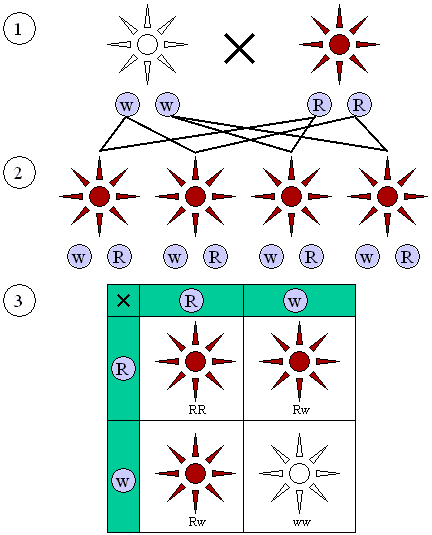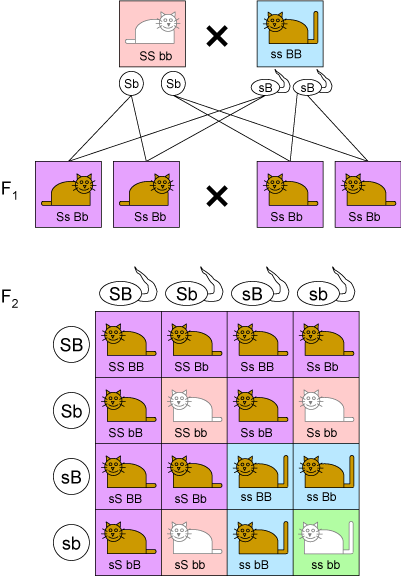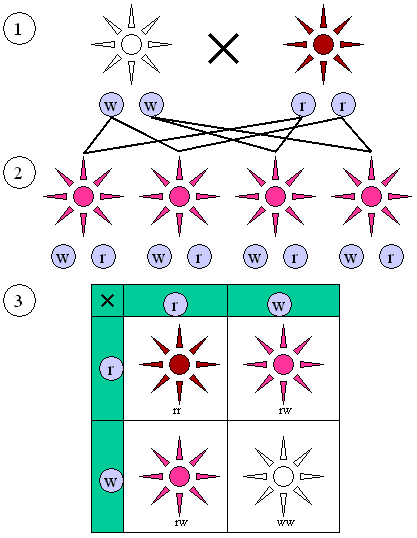Mendelian inheritance
Editor-In-Chief: C. Michael Gibson, M.S., M.D. [1]
Mendelian inheritance (or Mendelian genetics or Mendelism) is a set of primary tenets relating to the transmission of hereditary characteristics from parent organisms to their children; it underlies much of genetics. They were initially derived from the work of Gregor Mendel published in 1865 and 1866 which was "re-discovered" in 1900, and were initially very controversial. When they were integrated with the chromosome theory of inheritance by Thomas Hunt Morgan in 1915, they became the core of classical genetics.
History
The laws of inheritance were derived by Gregor Mendel, a 19th century Moravian[1] monk conducting plant hybridity experiments. Between 1856 and 1863, he cultivated and tested some 28,000 pea plants. His experiments brought forth two generalizations which later became known as Mendel's Laws of Heredity or Mendelian inheritance. These are described in his essay "Experiments on Plant Hybridization" that was read to the Natural History Society of Brno on February 8 and March 8, 1865, and was published in 1866.[2]
Mendel's results were largely neglected. Though they were not completely unknown to biologists of the time, they were not seen as being important. Even Mendel himself did not see their ultimate applicability, and thought they only applied to certain categories of species. In 1900, however, the work was "re-discovered" by three European scientists, Hugo de Vries, Carl Correns, and Erich von Tschermak. The exact nature of the "re-discovery" has been somewhat debated: De Vries published first on the subject, and Correns pointed out Mendel's priority after having read De Vries's paper and realizing that he himself did not have priority, and De Vries may not have acknowledged truthfully how much of his knowledge of the laws came from his own work, or came only after reading Mendel's paper. Later scholars have accused Von Tschermak of not truly understanding the results at all.
Regardless, the "re-discovery" made Mendelism an important but controversial theory. Its most vigorous promoter in Europe was William Bateson, who coined the term "genetics", "gene", and "allele" to describe many of its tenets. The model of heredity was highly contested by other biologists because it implied that heredity was discontinuous, in opposition to the apparently continuous variation observable. Many biologists also dismissed the theory because they were not sure it would apply to all species, and there seemed to be very few true Mendelian characters in nature. However later work by biologists and statisticians such as R.A. Fisher showed that if multiple Mendelian factors were involved for individual traits, they could produce the diverse amount of results observed in nature. Thomas Hunt Morgan and his assistants would later integrate the theoretical model of Mendel with the chromosome theory of inheritance, in which the chromosomes of cells were thought to hold the actual hereditary particles, and create what is now known as classical genetics, which was extremely successful and cemented Mendel's place in history.
Mendel's findings allowed other scientists to simplify the emergence of traits to mathematical probability. A large portion of Mendel's findings can be traced to his choice to start his experiments only with true breeding plants. He also only measured absolute characteristics such as color, shape, and position of the offspring. His data was expressed numerically and subjected to statistical analysis. This method of data reporting and the large sampling size he used gave credibility to his data. He also had the foresight to look through several successive generations of his pea plants and record their variations. Without his careful attention to procedure and detail, Mendel's work could not have had the impact it made on the world of genetics.
Mendel's Laws
Law of Segregation
The Law of Segregation, also known as Mendel's First Law, essentially has four parts.
- Alternative versions of genes account for variations in inherited characteristics. This is the concept of alleles. Alleles are different versions of genes that impart the same characteristic. For example, each human has a gene that controls eye color, but there are variations among these genes in accordance with the specific color for which the gene "codes".
- For each characteristic, an organism inherits two alleles, one from each parent. This means that when somatic cells are produced from two alleles, one allele comes from the mother and one from the father. These alleles may be the same (true-breeding organisms/homozygous e.g. ww and rr in Fig. 3), or different (hybrids/heterozygous, e.g. wr in Fig. 3).
- If the two alleles differ, then one, the allele that encodes the dominant trait, is fully expressed in the organism's appearance; the other, the allele encoding the recessive trait, has no noticeable effect on the organism's appearance. In other words, only the dominant trait is seen in the phenotype of the organism. This allows recessive traits to be passed on to offspring even if they are not expressed. Not all traits have a dominant-recessive relationship, however. The "Japanese wonder flower" Mirabilis jalapa illustrates incomplete dominance (Figure 3). There is also codominance e.g. Human blood types where A and B are codominant and O is recessive.
- The two alleles for each characteristic segregate during gamete production. This means that each gamete will contain only one allele for each gene. This allows the maternal and paternal alleles to be combined in the offspring, ensuring variation.
N.B It is often misconstrued that the gene itself is dominant, recessive, codominant, or incompletely dominant. It is, however the trait, or gene product that the allele encodes that is dominant, etc.
Law of Independent Assortment
The Law of Independent Assortment, also known as "Inheritance Law" or Mendel's Second Law, states that the inheritance pattern of one trait will not affect the inheritance pattern of another. While his experiments with mixing one trait always resulted in a 3:1 ratio (Fig. 1) between dominant and recessive phenotypes, his experiments with mixing two traits (dihybrid cross) showed 9:3:3:1 ratios (Fig. 2). But the 9:3:3:1 table shows that each of the two genes are independently inherited with a 3:1 ratio. Mendel concluded that different traits are inherited independently of each other, so that there is no relation, for example, between a cat's color and tail length. This is actually only true for genes that are not linked to each other.
 (1) Parental generation. (2) F1 generation. (3) F2 generation. Dominant (red) and recessive (white) phenotype look alike in the F1 (first) generation and show a 3:1 ratio in the F2 (second) generation |
 |
 (1) Parental generation. (2) F1 generation. (3) F2 generation. The "red" and "white" allele together make a "pink" phenotype, resulting in a 1:2:1 ratio of red:pink:white in the F2 generation. |
Background
The reason for these laws is found in the nature of the cell nucleus. It is made up of several chromosomes carrying the genetic traits. In a normal cell, each of these chromosomes has two parts, the chromatids. A reproductive cell, which is created in a process called meiosis, usually contains only one of those chromatids of each chromosome. By merging two of these cells (usually one male and one female), the full set is restored and the genes are mixed. The resulting cell becomes a new embryo. The fact that this new life has half the genes of each parent is one reason for the Mendelian laws. The second most important reason is the varying dominance of different genes, causing some traits to appear unevenly instead of averaging out (whereby dominant doesn't mean more likely to reproduce - recessive genes can become the most common, too).
There are several advantages of this method (sexual reproduction) over reproduction without genetic exchange:
- Instead of nearly identical copies of an organism, a broad range of offspring develops, allowing more different abilities and evolutionary strategies.
- There are usually some errors in every cell nucleus. Copying the genes usually adds more of them. By distributing them randomly over different chromosomes and mixing the genes, such errors will be distributed unevenly over the different children. Some of them will therefore have only very few such problems. This helps reduce problems with copying errors somewhat.
- Genes can spread faster from one part of a population to another. This is for instance useful if there's a temporary isolation of two groups. New genes developing in each of the populations don't get reduced to half when one side replaces the other, they mix and form a population with the advantages of both sides.
- Sometimes, a mutation (e. g. Sickle Cell Anemia) can have positive side effects (in this case Malaria resistance). The mechanism behind the Mendelian laws can make it possible for some offspring to carry the advantages without the disadvantages until further mutations solve the problems.
Mendelian trait
A Mendelian trait is one that is controlled by a single locus and shows a simple Mendelian inheritance pattern. In such cases, a mutation in a single gene can cause a disease that is inherited according to Mendel's laws. Examples include sickle-cell anemia, Tay-Sachs disease, cystic fibrosis and xeroderma pigmentosa. A disease controlled by a single gene contrasts with a multi-factorial disease, like arthritis, which is affected by several loci (and the environment) as well as those diseases inherited in a non-Mendelian fashion. The Mendelian Inheritance in Man database is a catalog of, among other things, genes in which Mendelian mutants causes disease.
See also
References
- ↑ Henig, Robin Marantz (2000). The Monk in the Garden : The Lost and Found Genius of Gregor Mendel, the Father of Genetics. Houghton Mifflin. ISBN 0-395-97765-7.
The article, written by an obscure Moravian monk named Gregor Mendel...
- ↑ See Mendel's paper in English: Gregor Mendel (1865). "Experiments in Plant Hybridization".
Additional References
- Peter J. Bowler (1989). The Mendelian Revolution: The Emergence of Hereditarian Concepts in Modern Science and Society. Baltimore
Genetics:The life of DNA
Publisher = ANDRNA press
Author = Jean Atics: Johns Hopkins University Press. line feed character in |location= at position 10 (help)
af:Wette van Mendel bg:Закони на Мендел ca:Lleis de Mendel cs:Mendelovy zákony dědičnosti de:Mendelsche Regeln et:Mendeli seadused el:Μεντελική κληρονομικότητα ko:멘델의 유전법칙 id:Hukum Pewarisan Mendel it:Gregor Mendel#Le_leggi_di_Mendel he:חוקי התורשה של מנדל hu:Mendeli öröklődés törvényei nl:Wetten van Mendel no:Mendels arvelover sk:Mendelizmus sr:Менделови закони Template:Jb1 Template:WH Template:WikiDoc Sources